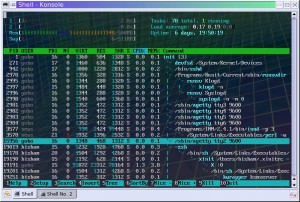Finally an interactive process viewer I can really get behind and use.

On the htop main website htop describes itself as “an interactive process viewer for LInux”. Almost every distro of Linux contains the standard process viewer top, but I have found that htop has been more useful to me as an actual tool instead of just a viewer.
As with other packages, I am a big fan of color when working from the command line. htop is great because it has several different color schemes that allow me to quickly find things that are important to me while ignoring the other stuff that I am not hunting for. Just the other day, I had a rogue process that was causing me problems and I could not find it. htop to the rescue, I was able to located the process that was hanging everything up and two keystrokes killed the process and I was on my way.

htop allows you to setup different meters and graphs so you can quickly review what is going on with the server such as server load, processor load, memory and swap loads. Another feature of htop is it allows you to run in tree mode. The tree mode is great for seeing what processes are spawned or owned by another process.

htop has become a valuable tool for us when monitoring production servers under heavy load. We have been able to use htop to isolate problems and address them head on. This package can be installed on RHEL or CentOS using YUM. Most of my fellow system administrators that work from the command line view htop as a great package. htop will also allow you to setup graphs for each of the processes on a multiprocessor machine. Machines with multiple cores will display each core as a separate processor. WHen you run htop on a quad core machine, it is very impressive when the machine is under head load.
htop has its home at sourceforge but you will find a link to htop on our toolkit page.
htop is CodingCREW approved and recommended, but only for those that know how to use it.